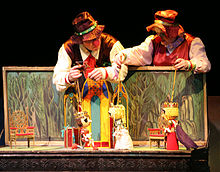
Russian puppet theater appears to have originated either in migrations from the Byzantine Empire in the sixth century or possibly by Mongols travelling from China. Itinerant Slavic minstrels were presenting puppet shows in western Russia by the thirteenth century, arriving in Moscow in the mid-sixteenth century. Although Russian traditions were increasingly influenced by puppeteers from western Europe in the eighteenth century, Petrushka continued to be one of the principal figures. In addition to glove puppets and marionettes, rod puppets and flat puppets were introduced for a time but disappeared in the late nineteenth century.
Today's puppet theaters owe much of their popularity to Nina Simonovich-Efimova and her husband who received support from the Russian authorities shortly after the October Revolution to set up a puppet theater in Moscow. They introduced a number of innovative designs and presented a range of performances for both children and adults. Sergey Obraztsov, who performed classical folk tales with glove puppets and marionettes, established his own theater in 1938. Puppet performances became increasingly widespread during the Soviet era and have remained popular ever since.